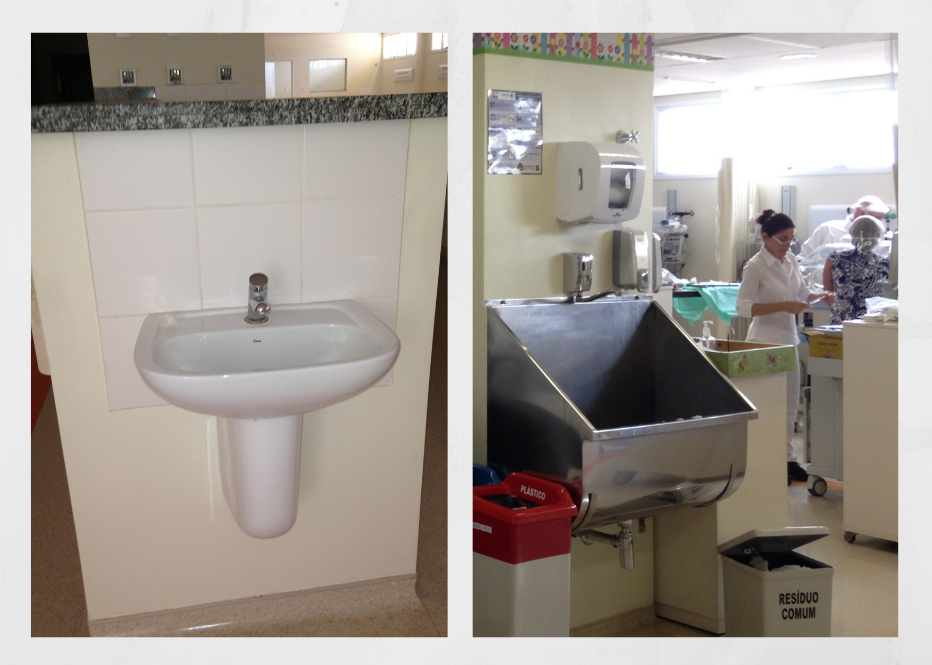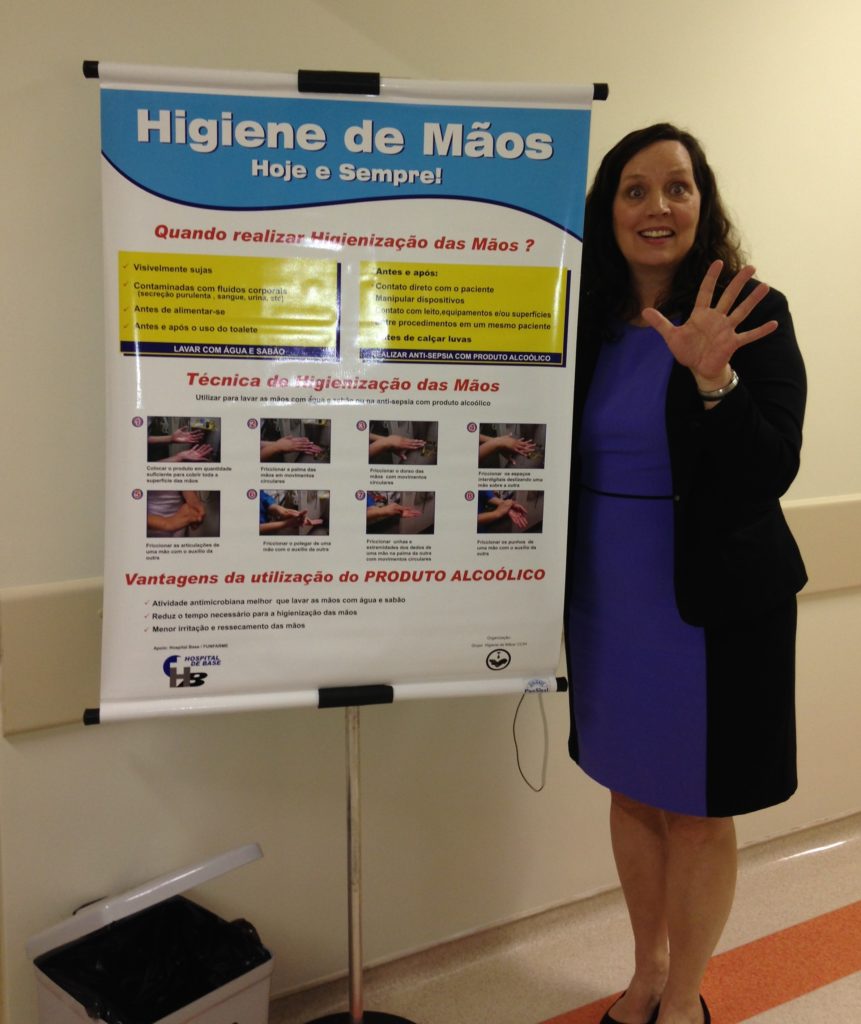
Patsy Stinchfield receives a plaque from Dr. Ulisses Croti in honor of our 10-year partnership. Also in the photo: Andreas Tsakistos, Children’s HeartLink country director. June, 2018
Surgeons, cardiologists, respiratory therapists, intensivists, anesthesiologists, scrub and ICU nurses – this is a long list, yet not a comprehensive list of specialists who are on our volunteer teams, traveling to our partner hospitals to train and mentor their peers around the world.
Meet our medical volunteer, Patsy Stinchfield, MS, CPNP, CIC, an infectious disease pediatric nurse practitioner who is board certified in infection control and is the senior director of Infection Prevention and Control, the Wound Care Team and The Children’s Immunization Project at Children’s Minnesota.
Her decision to become a Children’s HeartLink volunteer was affected by her own, very personal story. In 1987, at age 30, Patsy was hired by Children’s Hospitals and Clinics of Minnesota (now Children’s Minnesota). During her employee physical, she was surprised to learn that she had a congenital heart defect. She had corrective open heart surgery a few weeks after being diagnosed.
“When I was watching Dr. Ulisses Croti do open heart surgery in Brazil, I was thinking: ‘I had the surgery I’m watching now.’”
Patsy’s sinks and nail revolution
Patsy’s expertise and recommendations for infection control helped Hospital da Criança e Maternidade in Brazil make great strikes in reducing infection rates among children recovering in the hospital after heart surgeries. She was referred to this hospital because frequent surgical site infections were a big concern in its cardiac unit.
When Patsy was on her first trip in São José do Rio Preto, where the hospital is located, she noticed right away that many nurses had long and artificial fingernails.
“The long and artificial nails are such an important part of their feminine culture in Brazil. I wondered how I might introduce the problem of infection associated with long fingernails which are well-known to harbor fungus and bacteria dangerous to vulnerable patients.”
She decided to show the staff some photos of infections associated with long nails. The next day all the women in the cardiac unit walked up to Patsy and held up their hands. Their artificial nails had been removed and their fingernails were cut short.
“I was so struck with their eagerness to learn and be better. It was about protecting the kids. I was really touched by that.”

Old and new sinks at Hospital da Criança e Maternidade, Brazil
She also found hospital sinks to be too small, only 12 by 12 inches.
“During a handwashing demonstration: Fingertips first, then wrists, then elbows… I couldn’t get my arm under the faucet.”
The hospital team brought in an engineer to install larger sinks and called them ‘Patsy’s sinks.’
“Now, their sinks are big enough to wash your car in,” laughs Patsy.
Child at the top
Patsy has traveled with Children’s HeartLink to São José do Rio Preto three times. Her first two trips were 2 years apart, in 2012 and 2014. The last one was more recent, in June 2018.
During her visits, she wanted the Brazilian team to embrace the culture of patient safety. She demonstrated to them that it’s not about the surgeon, the intensivist or the nurse, with the patient last. The child belongs at the top of the pyramid, and the team is more important than the individual. This allows everyone the right to freely speak up if they see something potentially harmful to the child.
“One of the biggest transitions from the first and third trips, and I saw it first-hand, was that the environment became much nicer to work in. It became the environment, where when they succeeded, they all succeeded. When they failed, they all failed. Their patient outcomes improved. This was about so much more than sterile gloves and a larger sink. The team there embraced the whole culture of safety.”
Patsy also encouraged the staff to use all the resources they have available in order to provide safe critical care for children.
“Call your infection control people. They are as knowledgeable as we are. If they can’t answer your question, then call me. They are now a full part of the team. They deserve to be part of the fold because they’re good at what they do.” With this teamwork, the bloodstream infections, post-op surgical site infections and infant mortality have dramatically reduced.

Patsy doesn’t take credit for the hospital’s improvement in infection control.
“It makes me feel so good to see those improved infection rates they have. I don’t personally take credit for it. But the team was wholeheartedly on board with what I recommended, and they built it into their practice.”
The partnership between Children’s HeartLink and Hospital da Criança e Maternidade is now embarking on its tenth year and is poised to become a Children’s HeartLink Center of Excellence. The 10-year collaboration led not only to a significant decrease in infection, but also to an increase in the number of children treated and the complexity of their surgeries, as well as to a reduction in deaths. Last year, the hospital served over 3,300 children with heart disease and performed over 300 heart surgeries.
“Here’s what stands out about my trips with Children’s HeartLink: the eagerness of the team to improve, to be better doctor, nurses, respiratory therapists, infection preventionists and even environmental services staff. They almost wanted to make changes on the spot,” remembers Patsy. “It was a joy working with them.”
Nothing but fulfilling and rewarding
Patsy says that going on medical volunteer trips has been fulfilling and life-changing.
“Volunteers get more than they give, and they give a lot. You come home, and you feel satisfied, and it’s been nothing but fulfilling and rewarding ever since.”
Her enthusiasm became contagious, and she has inspired other nurses to become volunteers. Two other nurse infection preventionists and a respiratory therapist from Children’s Minnesota were encouraged by Patsy to go to Brazil and help make a difference.
“My friend, a labor and delivery nurse, was invited to teach at a hospital in Tanzania with a different volunteer program. My instructions to her were clear, ‘Be aware of what you give AND what you get.’ Her return was celebrated by the two of us discussing how rewarding it is to volunteer your knowledge to others, especially when you have traveled many miles; a part of you is left behind forever.”
“All you have to do is go once, and you’re hooked,” says Patsy.
Share your story on our 50 Years Blog! If you were a host family or if you have a Children’s HeartLink story or photos, please contact us: hello@childrensheartlink.org.
